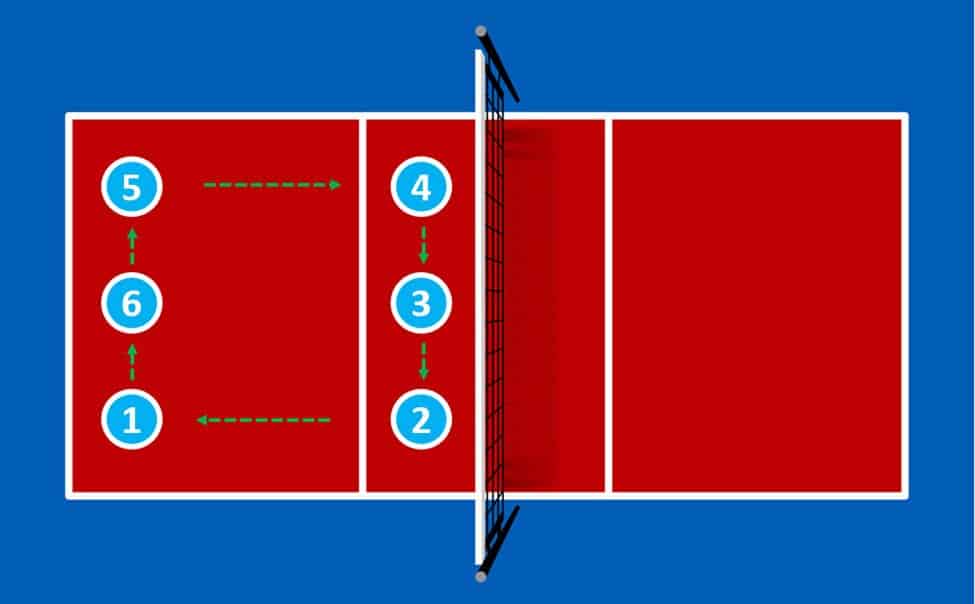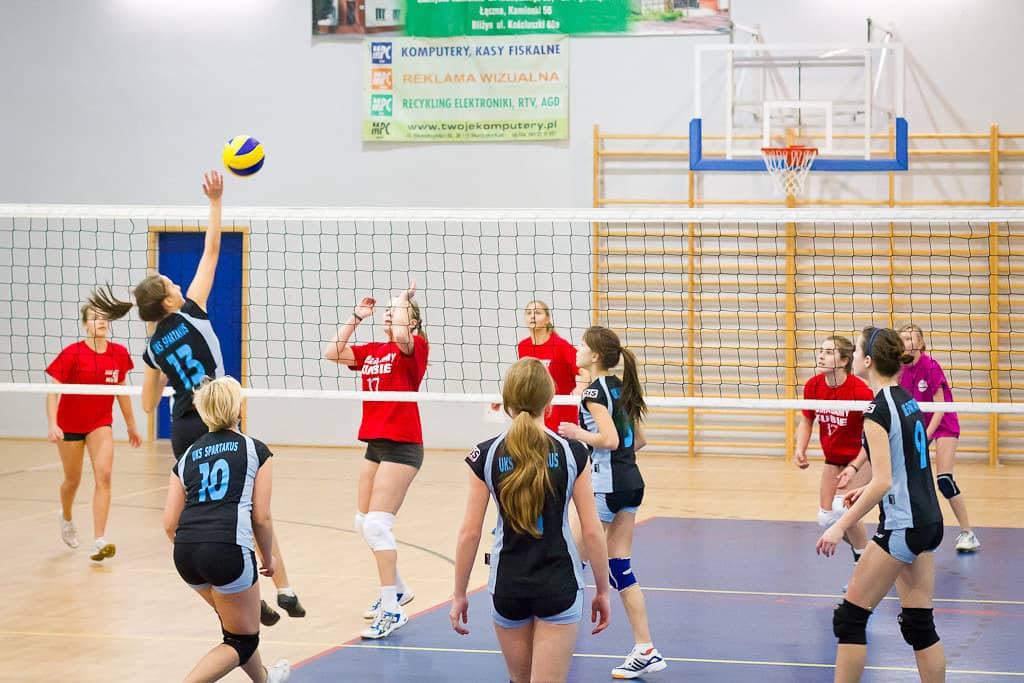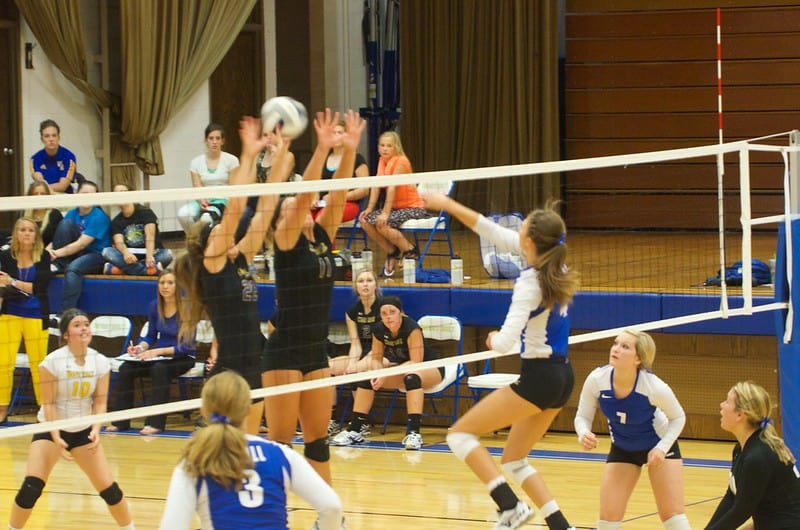A very common question when people are new to the sport of volleyball is: When are you supposed to rotate? In volleyball, every time your team wins a rally and regains possession of the serve, your team rotates. If it is the first service of the game for your team, you don’t rotate. When you win points for which your team began the rally with a serve, you don’t rotate.
The Different Meanings of “Rotation” in Volleyball
In volleyball, the term “rotation” has several meanings and what makes it extra confusing is that the different ideas are sometimes inter-related.
Rotation: The Act of Rotating Through the Starting Serving Positions
The basic starting positions of a rotation are numbered 1 through 6, where 1 is the server’s box (the back right corner), then going to the front, the positions are 2, 3, and 4 going right to left (when facing the net), then back to the back row, all the way on the left is 5, and center is 6.

So when your team regains the possession of the serve, everyone “rotates” in a clockwise motion, with every player moving 1 position in the order in the image above. As an act, this is called “rotating,” or “rotation”.
Many people are confused by this numbering system becaues it seems to go in the opposite direction that the players are moving. Think of it as the order of the next player to serve for your team and it’s counting down to #1.
Rotation As a Lineup
Coaches will strategically place players on the court based on their strengths in the right order and sometimes it is called a rotation. When a ref calls a team for being “out of rotation” they are referring to the players not being in the right order according to their lineup. This can happen even if a player is one step too far in front of another or when a player moves before the ball has been served.
Rotation As a Scheme
A scheme is when a team is deciding what kind of play they are going to be running. Sometimes coaches and players will refer to this as a rotation. This is especially important in serve recieve because the hitters may not be in their traditional position. It is the setters job to communicate what the hitters will be doing.
When Does My Team Rotate?
Your team needs to rotate each time you win the possession of the serve again. So the first time you’re serving, your team will not rotate because your first server has not yet served during this game. Once you lose possession of the serve and then win it back, you’ll rotate again.
The idea is that each player will get a turn to serve, as well as be put in the position to have to play from each area of the court. There are strategies that players and coaches will use to avoid weaknesses while rotating through positions, and that’s where some of the fundamental strategies of volleyball really come into play.
If a particular player is weak at serving, the coach may substitute another player in their place, possibly just for the service, or possibly for the three positions on the back row. There are all kinds of detailed rules about how you can stand and still adhere to the 6 base rotational positions.
Usually the libero, who should be the best defensive player on the team, will swap places with one or even two of the weakest players on the team during their back row part of their rotation on a consistent basis. The libero can effectively cover for 2 players that are great attackers in the front by replacing them during the back part of the rotation, as long as the attackers are directly opposite, allowing the libero to seamlessly alternate between one position and the other as they rotate from back to front.
How to Follow and Understand the Rotation as a Fan
As a fan, it can be pretty confusing, especially at the higher levels of volleyball, to know where your favorite players is supposed to be in the rotational lineup. Part of the reason it’s so hard to keep track of is because the players DO NOT stand in 2 straight rows of 3 like in the image above! Whether it’s your child, your grandchild, or your friend, I’d like you to be able to understand the game as you cheer, because it makes it more fun if you understand what you’re seeing.
The WRONG Way to Track the Rotation as a Fan
The common mistake that will mess you up is to focus on the libero. Because of their different jersey, it’s easy to always spot them and it’s tempting to just track their movement.
The problem with this is that they never make it to the front court and they substitute in and out for different players. For many teams, the libero will have a certain part of the rotation where they will rotate from the number 5 position to the number 1 position (meaning they will serve), without coming off the court! This is because they have essentially substituted off the court with one player, and back in for another player.

The RIGHT Way to Track the Rotation as a Fan
So what’s the RIGHT way to follow the rotation of your team? Follow the setter. You can find the setter pretty quickly when begin to watch a game because they should be the player making the second touch on the ball nearly every play.
When you watch the setter, other players will adjust around them, sometimes lining up ahead, behind or to off to the side of where you would expect them to. This is because setters are like the leader of the offense and need to be in specific positions as they move around the court to be free to command the offense as early in the play as possible.
So if you can identify your team’s setter, and then see where your favorite player is in relation to the setter, you’ll always be able to keep track of where your favorite player should be.
Why Do We Have to Rotate in Volleyball?
Obviously it’s part of the rules of the game, but WHY do the rules force teams to rotate? The truth is that this makes the game so much more fun, strategic, and competitive. If there is no rotation – like in a fun, casual pickup game, you’ll see the same players stay in the same spot and it becomes very boring and repetitive.
The whole point of rotating is so that players have to navigate the challenges of playing in different parts of the court, stretching them to play beyond their expertise. This pays off for well-rounded players who have a diverse set of skills and for teams that are well-balanced, who have a good mix of talent.
Volleyball Rotation and Substitutions
When substitutions occur, the player coming in now occupies the same rotational position that the player they replaced used to occupy. Everyone else on the court should now recognize that they hold that same space in the lineup.
When the libero swaps out with a player on the backrow, they must maintain that players rotational position until they swap back out. As the other players rotate, they move through the rotation as well, even though they are able to swap with any backrow player, they are filling one specific lineup space at a time.
These changes are what is being recorded by the person who is “keeping the book” at the scorer’s table. They are tracking which player is occupying each of the 6 base rotational positions, and making sure the lineup order is maintained through the game.
If you would like a more in-depth look at the advanced strategies of rotation, check this article out next: The 8 Parts To Understanding Rotation In Volleyball
Advanced Rotation Systems
Advanced teams, or pretty much all teams at the higher levels of volleyball will use advanced strategic systems to try to create an advantage.
How Scheme Affects Volleyall Rotation
You may see different schemes that are called 5-1, 4-2, and 6-2 Rotations. In each of these, the first number is listing the number of attackers on the floor, the second is the number of setters that are in your lineup. In each case, the coach is trying to use their team’s unique attributes to create the strongest combination of offense and defense to create an advantage.
Lineup Changeup
There can be an invisible chess match going on between coaches sometimes. Your coach will submit a new lineup with each and every set. You may see them repeat the same lineup in back-to-back sets, and other times it will be completely different each time.
Your coach is trying to exploit your opponents weaknesses in their lineup, while also trying to protect against your own weaknesses. As a coach, it’s not simply positioning your middle hitter beside your setter and your outside hitter next to them, it’s also taking the other team’s lineup into consideration and understanding the blocking faceoffs, who will be on defense during the strongest servers, and other hard situations that will happen.

Stacking in Volleyball
One way that your team can position themselves for success is to “push up” players, or “hide” players by lining up far to one side or another, or further forward or back than you would normally expect in the base 6 positional rectangle. As long as they follow the rules, it’s perfectly legal.
Rotation Mistakes Have Consequences
Loss of point, loss of serve (if you had it), confusion, loss of momentum or rhythm.
Why mistakes happen – forgetting that you swapped with another player during the last play, forgetting the rules where you are stacking to be rotationally correct, etc.
Importance of practicing rotation and mental awareness.
Tips for Remembering Your Rotation
Beginners: When you’re new to the sport, just focus on moving through the 6 base positions. You’ll rotate clockwise around the court, so just remember who is ahead of you and follow them, taking their position.
Advanced players: When you’re playing at a higher level, a major consideration is shifting so that your setter is not receiving the service. Think about it – if your setter takes the first touch, then who is setting the ball for the attack? So your setter will “push up” one of the hitters on the front row. There are certain rules about where the setter can stand so that they will not be called for being “out of rotation”. The coach can decide which hitter she would like to step back and play serve recieve, or if you have two really great passers the coach can let just the two of them take care of serve recieve.
Mindset: It is always helpful as a player to know where your setter is on the court because your rotation will always be set up around them.
If you are a libero and still have questions about how you fit into the rotation, make sure to review this post next: Master Guide To Liberos In Volleyball: Rules, Rotation, And Tips
Resources:
Rotation positions images are from SportsEdTV: https://sportsedtv.com/blog/Volleyball%20Rotations%20Explained
Featured image photo by Tom Fisk: https://www.pexels.com/photo/young-girls-playing-in-a-volleyball-match-17591649/
Recent Posts
Athletes, listen up! Do you have a closet full of old jerseys, sweatpants, and tees that you just can't seem to part with? Well, dust them off, because you're sitting on a goldmine of fashion...
You may have heard, or you may have noticed, that there's been a change to the rule about double contact in volleyball. In 2022, an experimental rule change began to be implemented, where the double...
